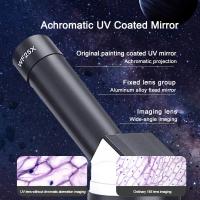What Is The Biggest Microscope ?
The biggest microscope is the Large Hadron Collider (LHC) located at CERN in Switzerland. Although it is not a traditional microscope, it is used to study the smallest particles in the universe, such as protons and neutrons. The LHC is a particle accelerator that uses a 27-kilometer ring to accelerate particles to nearly the speed of light and then collide them together. The collisions produce a shower of particles that can be detected and analyzed by scientists. The LHC is the largest and most powerful particle accelerator in the world, and it has been used to make many important discoveries in particle physics.
1、 Scanning Transmission Electron Microscope (STEM)
The biggest microscope is the Scanning Transmission Electron Microscope (STEM). This type of microscope uses a beam of electrons to create high-resolution images of samples at the atomic scale. STEMs are capable of producing images with resolutions as small as 0.05 nanometers, which is about 100 times smaller than the resolution of a traditional light microscope.
STEMs are used in a variety of fields, including materials science, biology, and nanotechnology. They are particularly useful for studying the structure and properties of materials at the atomic level, which is important for developing new materials with specific properties.
One of the latest developments in STEM technology is the integration of aberration correction. This technology corrects for aberrations in the electron beam, which can improve the resolution and clarity of the images produced by the microscope. Aberration correction has allowed researchers to study materials with unprecedented detail, revealing new insights into their structure and properties.
STEMs are also being used in combination with other techniques, such as spectroscopy and tomography, to provide even more detailed information about samples. For example, STEM tomography can be used to create 3D images of samples, allowing researchers to study their structure in three dimensions.
Overall, the Scanning Transmission Electron Microscope is the biggest microscope and continues to be a powerful tool for studying materials at the atomic scale. With the latest advancements in technology, STEMs are providing researchers with new insights into the structure and properties of materials, which has important implications for a wide range of fields.

2、 Focused Ion Beam Scanning Electron Microscope (FIB-SEM)
The biggest microscope is the Focused Ion Beam Scanning Electron Microscope (FIB-SEM). This advanced microscope is capable of producing high-resolution images of materials at the nanoscale level. It uses a focused beam of ions to remove material from a sample, allowing for the creation of three-dimensional images with extremely high resolution.
The FIB-SEM has revolutionized the field of materials science, allowing researchers to study the structure and properties of materials in unprecedented detail. It has applications in a wide range of fields, including electronics, materials science, and biology.
One of the latest developments in FIB-SEM technology is the use of machine learning algorithms to automate the imaging process. This allows for faster and more efficient imaging, as well as the ability to analyze large datasets in real-time.
Another recent development is the use of cryogenic FIB-SEM, which allows for the imaging of samples at extremely low temperatures. This has opened up new avenues of research in fields such as cryo-electron microscopy and cryogenic materials science.
Overall, the FIB-SEM is a powerful tool for studying the nanoscale world, and its continued development is sure to lead to new breakthroughs in a wide range of fields.

3、 Helium Ion Microscope (HIM)
The Helium Ion Microscope (HIM) is currently considered the biggest microscope in terms of its imaging capabilities. It uses a beam of helium ions instead of electrons, which allows for higher resolution imaging and less damage to the sample being observed. The HIM can achieve resolutions of less than 0.5 nanometers, which is significantly better than traditional electron microscopes.
One of the advantages of the HIM is its ability to image non-conductive materials, such as ceramics and polymers, without the need for special preparation techniques. This makes it a valuable tool for materials science research, as it allows for the observation of materials in their natural state.
Another advantage of the HIM is its ability to perform in-situ experiments, where the sample can be manipulated and observed in real-time. This allows for a better understanding of the behavior of materials under different conditions, such as temperature and pressure.
The HIM is also being used in the field of biology, where it has been used to image biological samples at high resolution. This has the potential to provide new insights into the structure and function of biological systems.
Overall, the HIM is a powerful tool for imaging and analyzing a wide range of materials and biological samples. Its high resolution and ability to image non-conductive materials make it a valuable addition to the field of microscopy.

4、 X-ray Microscopy (XRM)
The biggest microscope is X-ray Microscopy (XRM), also known as X-ray tomography. XRM is a non-destructive imaging technique that uses high-energy X-rays to penetrate through materials and create 3D images of their internal structures. XRM can provide high-resolution images of samples ranging from a few micrometers to several centimeters in size.
XRM has become an increasingly popular technique in materials science, biology, and geology due to its ability to provide detailed information about the internal structure of materials. XRM can be used to study the microstructure of materials, such as the distribution of pores, cracks, and other defects. It can also be used to study the internal structure of biological samples, such as cells and tissues.
The latest point of view on XRM is that it has the potential to revolutionize the field of materials science. XRM can provide detailed information about the internal structure of materials, which can be used to optimize their properties and performance. For example, XRM can be used to study the microstructure of materials used in energy storage devices, such as batteries and fuel cells, to improve their efficiency and durability.
In addition, XRM can be used to study the internal structure of rocks and minerals, which can provide insights into the formation and evolution of the Earth's crust. XRM can also be used to study the internal structure of fossils, which can provide insights into the evolution of life on Earth.
Overall, XRM is the biggest microscope due to its ability to provide high-resolution images of the internal structure of materials and its potential to revolutionize the field of materials science.






































